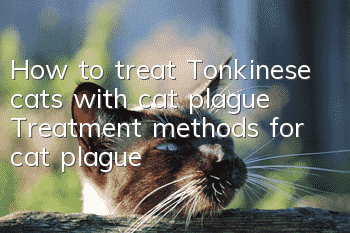How to treat Tonkinese cats with cat plague? Treatment methods for cat plague

How to treat a Tonkinese cat with cat distemper? Feline distemper is a relatively common cat disease. Many novice poop collectors do not know much about this disease. So how to treat cats with cat distemper?
The method of treating feline plague in Tonkinese cats mainly focuses on parenteral infusion to supplement electrolytes and nutrients, correct dehydration, improve vomiting symptoms, and administer broad-spectrum antibiotics to prevent secondary bacterial infections, such as when severe anemia occurs. , whole blood or plasma transfusion should be considered. Of course, prevention is always better than treatment, so giving vaccinations in advance to protect Tonkinese cats is the best way.
Mild cases of Tonkinese cats, especially in the early stages of the disease, should be treated under isolation conditions.
Sick cats are severely dehydrated due to diarrhea. Therefore, timely and decisive infusion is required in the early stage of the disease to adjust the balance of body fluids and electrolytes and correct body acidosis. The amount of infusion should be determined according to the condition, especially the degree of dehydration, and is generally about 50 ml per kilogram of body weight.
Secondly, carry out antibacterial and anti-inflammation. Various antibacterial drugs have no medical effect on feline parvovirus and are mainly used to prevent secondary infections. In addition, some auxiliary therapies can be used, such as giving hemostatic drugs, 10% glucose injection, vitamin drugs, etc.
1. Be sure to keep warm.
Feline distemper hyperimmune serum is very important. It is actually an antibody to the feline distemper virus. In treatment, it is the only one that specifically targets the virus. But be careful not to inject for more than three days in a row, as more may cause side effects.
2. Rehydration balance and prevention of acidosis.
Infusion is the best treatment method. If you cannot give Tonkinese cat infusion, you can feed him a mixture of 10% glucose injection and normal saline at regular intervals to help him replenish energy and water.
3. Use antibiotics to prevent secondary infections.
Commonly used antibiotics include gentamicin, which is given twice a day and 20,000 units at a time. There is now a new antibiotic drug for animals called Pukansu. You can consult your doctor for specific dosage.
4. Antivomiting.
Metoclopramide injection is a good antiemetic drug and is very important during treatment. It can be injected or taken orally.
5. Regulate digestive function.
During the treatment period, due to the ingestion of a large amount of antibiotics, the Tonkinese cat’s normal digestive flora was also destroyed during the treatment. The Tonkinese cat needs to be given some digestion-regulating drugs such as lactase, and the whole Enterobacteriaceae, etc., but it should be noted that these drugs should be used during the recovery period of cat plague, that is, when Tonkinese cats start eating, and they should be combined with antibiotics.Take antibiotics at least half an hour apart.
6. Other drugs such as dexamethasone and VC are drugs that help metabolism and can be added depending on the situation.
- A cat will die if it urinates for a few days
- Should you deworm yourself or go to a pet store?
- Are cat teasers harmful to cats?
- What should I do if my cat suffers from chronic gingivitis?
- Cat's nails are cracked with a thin layer
- Cats go crazy after eating mutton
- What does cat moss on a cat’s chin look like?
- Can cats reproduce after abdominal transmission is cured?
- What exactly is the sterilization shot for female cats?
- Can I still eat unopened cat food if it has expired?



